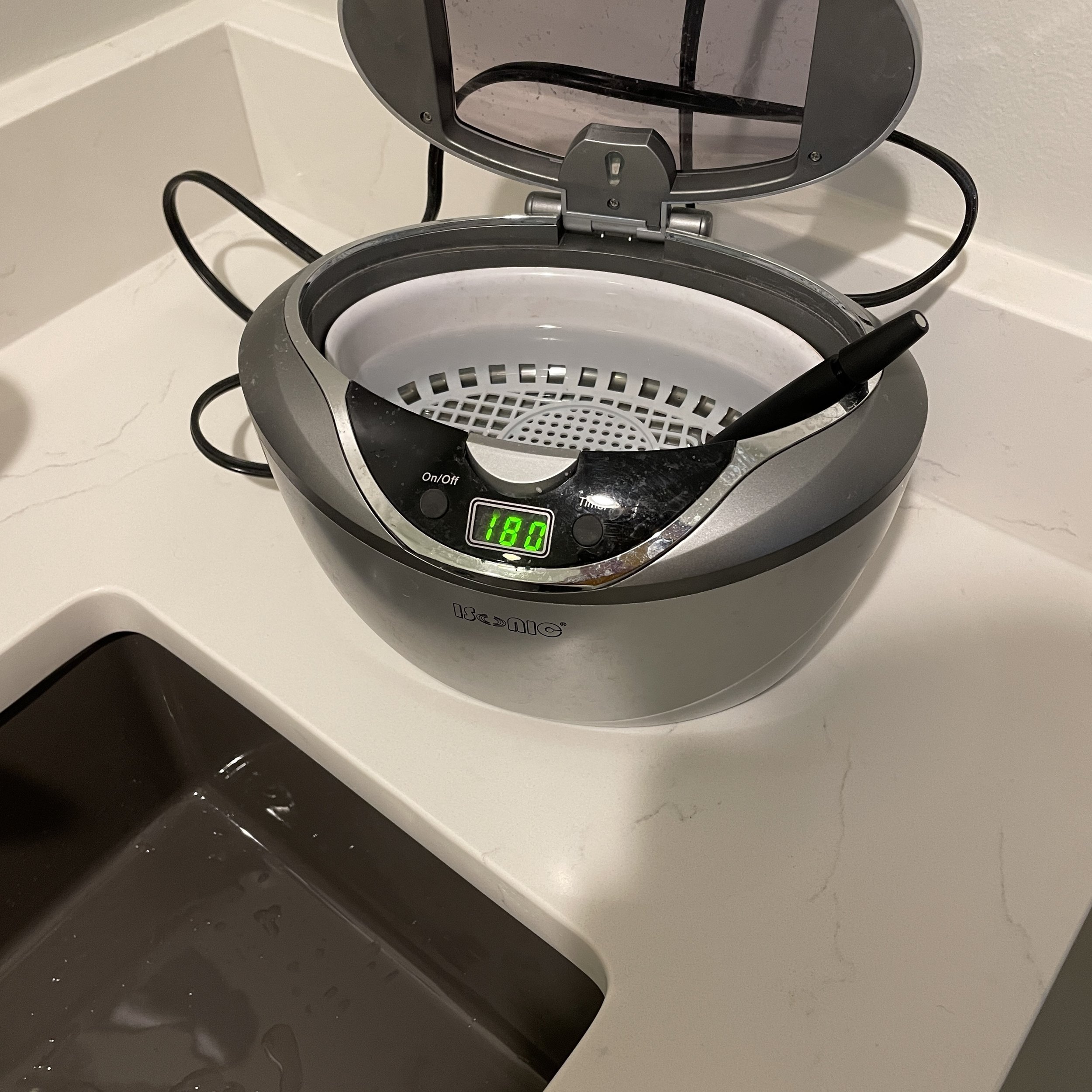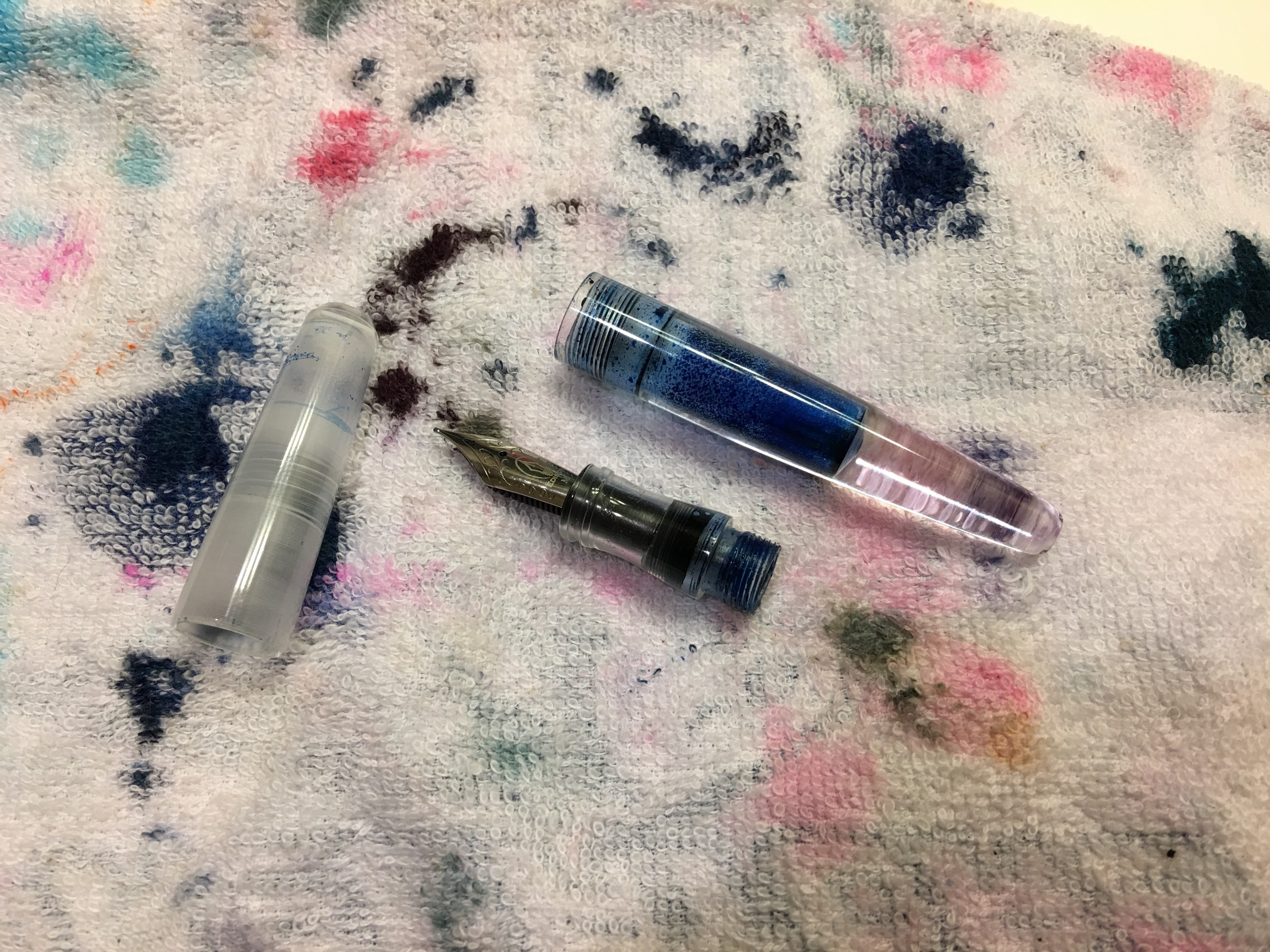Every once in a while I like to take things back to basics and talk a bit about how to care for, maintain, and store fountain pens. While not as “high-maintenance” and messy as some would have you believe, fountain pens definitely require more attention than your typical ballpoint or rollerball in order to maintain an enjoyable writing experience. So what brought this particular topic to mind today? Well, I finally have a sink in my dedicated work area, so I can actually flush out some pens that I’ve been waiting to clean since the Baltimore Pen Show back in March.
For 90% of cleaning jobs, you need little more than a glass of water, a towel, and (maybe) a bulb syringe.
My cleaning process is pretty simple, and I follow three steps:
Start (and Finish) With Water. Most of the time, since I use fairly unexciting inks without permanence, shimmer, sparkles, extreme iron gall content, etc., I can make do with a glass of water. I can flush the pen by running plain water through the filling mechanism 5 or 6 times, and that’s typically more than sufficient to clean the pen to a point where you won’t have old ink drying up in the feed and clogging the pen, nor will you see traces of the previous ink when you go to refill it. To dry the pen out I will usually (GENTLY) place the pen nib down in a glass with a folded paper towel or tissue at the bottom for padding, which will wick out any remaining inky water. Note: Some people will probably flip out when they hear that I place the flushed pens nib-down to dry. I’ve never damaged a pen this way but as with everything here, proceed at your own risk and do what you are comfortable with.
Proceed to Water + Dish Detergent for Stubborn Messes. If I have a fountain pen where the ink has dried out, or a pen that was inked with a super-saturated color or shimmer ink, I will add a drop of dish detergent (i.e., Dawn) to a large glass of water and repeat step one. 9/10 times, this fixes any problem I have cleaning stubborn pens. In my experience, “pen flush” or dedicated cleaning fluids are almost always unnecessary, though they can sometimes speed up the cleaning process. Buy them from a pen store (preferably a pen manufacturer) and don’t try to make your own with ammonia, diluted Windex, etc. Certainly don’t use them with expensive pens or rare materials like celluloid or other vintage plastics because you never truly know what’s in them or how the material will react.
Buy a Bulb Syringe. For either of these first two steps, you might want to pick up a bulb syringe. For cartridge-converter pens, it’s easier to flush water through the section using the bulb syringe than it is the converter, which doesn’t move much water at all. Just be sure to grip the section firmly because a bulb syringe can form a seal and cause the section to go shooting across the room if you’re not careful.
Buy an Ultrasonic Cleaner. IF you think you need one. That’s a big “IF” for me, because I hardly ever break mine out, and when I do it’s for pens like the Parker 51, Lamy 2000, or other hooded-nibs where flushing the pen is inadequate because it doesn’t necessarily get water to all parts of the feed. Vacumatic fountain pens are also easier to clean with an Ultrasonic, since the filling mechanism doesn’t push water through the feed with much force.
Cartridge-Converter section with a bulb syringe attached. It takes no time at all to clean a nib/section using the bulb syringe to flush water through the feed.
For tough jobs, a $40 ultrasonic jewelry cleaner (purchased at Bed, Bath & Beyond or Amazon on sale) is all the “heavy equipment” you’ll need. I typically use plain water, though you can add a drop of dish detergent if you like. Just be sure to flush the pen clean afterwards. (And if you’re considering remodeling, a grey or black sink is a nice upgrade to your “pen room” to hide the ink stains!)
Drying cleaned fountain pens nibs-down, which allows any remaining inky water to leach out. Just be sure to rest the nibs on a folded paper towel. As you can see, I don’t baby my pens.
Final Thoughts and Further Reading
To summarize my philosophy on cleaning fountain pens: Clean relatively frequently and go slowly, only adding substances other than water to the cleaning process if absolutely necessary. I think you’ll find that for most inks and most pens, it’s not. For some additional information and further reading on techniques for cleaning specific types of filling systems, check out this previous post.
I will likely do a further post on this topic at a later date, but favorite high-ink-capacity pens that are easy to clean include the TWSBI 580 piston filler, and the Opus 88 Japanese-style eyedroppers. I was able to flush all of these demonstrator pens perfectly clean in less than a minute since the sections separate and allow you to access the interior. Run them under the sink and/or flush them with a syringe.
This post does not contain third-party affiliate links. The Gentleman Stationer is supported entirely by purchases from the T.G.S. Curated Shop, and memberships via the T.G.S. Patreon Program.



